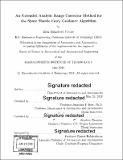| dc.contributor.advisor | Jonathan P. How and Stephen Thrasher. | en_US |
| dc.contributor.author | Evans, Erin Elizabeth | en_US |
| dc.contributor.other | Massachusetts Institute of Technology. Department of Aeronautics and Astronautics. | en_US |
| dc.date.accessioned | 2018-11-28T15:41:55Z | |
| dc.date.available | 2018-11-28T15:41:55Z | |
| dc.date.copyright | 2018 | en_US |
| dc.date.issued | 2018 | en_US |
| dc.identifier.uri | http://hdl.handle.net/1721.1/119296 | |
| dc.description | Thesis: S.M., Massachusetts Institute of Technology, Department of Aeronautics and Astronautics, 2018. | en_US |
| dc.description | Cataloged from PDF version of thesis. | en_US |
| dc.description | Includes bibliographical references (pages 99-101). | en_US |
| dc.description.abstract | Space shuttle entry guidance with an extended analytic range corrector method is presented. The guidance method is a variation of Shuttle entry guidance in which the parameters that define the drag profile are modified using quadratic splines to make the drag profile smooth and easier to customize. In general, in order to account for off-nominal entry conditions and ensure the vehicle flies the correct range to the runway, the nominal reference drag profile is modified on-line utilizing analytic expressions for the derivative of range with respect to the relevant drag profile parameter. This new profile is then used to calculate a reference drag command in the subsequent guidance algorithm cycle. Typical implementations of Shuttle entry guidance modify the drag profile using only one variable to shift the profile by a constant value. This presents problems when the vehicle is highly constrained and can easily violate constraints such as heat load and heat rate constraints due to small drag profile variations. The methods by which the drag profile is updated are changed in order to provide multiple perturbation options. In providing multiple drag profile update parameters, a memoryless range error allocator is implemented with a vector of weights as a design variable. The allocator parameters are designed to take into account heat load while remaining within constraints using a high L/D vertical takeoff horizontal landing reusable launch vehicle simulation. The resulting algorithm seeks to leverage the high-TRL Shuttle entry guidance routine by making minimal modifications to the implementation, while increasing robustness to entry interface dispersions under tight heating constraints. A discussion of the design of the drag profile is included, in which the selection of profile update parameters is explored. Results from optimization of these parameters using a genetic algorithm are presented, as well as Monte Carlo results demonstrating that the allocator can reduce failure rates due to tight drag constraints from 42% to 0%, establishing the impact and success of this analytic range corrector method. | en_US |
| dc.description.statementofresponsibility | by Erin Elizabeth Evans. | en_US |
| dc.format.extent | 101 pages | en_US |
| dc.language.iso | eng | en_US |
| dc.publisher | Massachusetts Institute of Technology | en_US |
| dc.rights | MIT theses are protected by copyright. They may be viewed, downloaded, or printed from this source but further reproduction or distribution in any format is prohibited without written permission. | en_US |
| dc.rights.uri | http://dspace.mit.edu/handle/1721.1/7582 | en_US |
| dc.subject | Aeronautics and Astronautics. | en_US |
| dc.title | An extended analytic range corrector method for the space shuttle entry guidance algorithm | en_US |
| dc.type | Thesis | en_US |
| dc.description.degree | S.M. | en_US |
| dc.contributor.department | Massachusetts Institute of Technology. Department of Aeronautics and Astronautics | |
| dc.identifier.oclc | 1061559446 | en_US |
